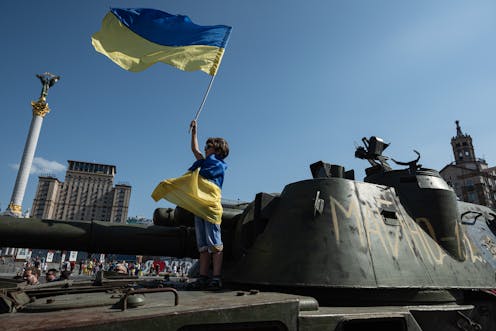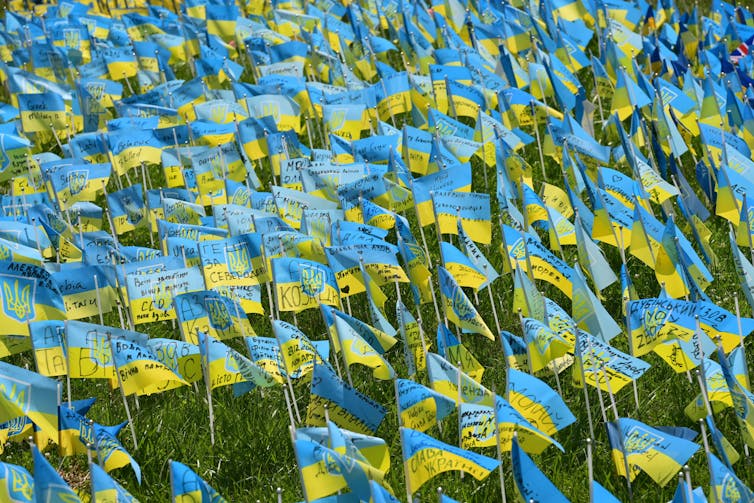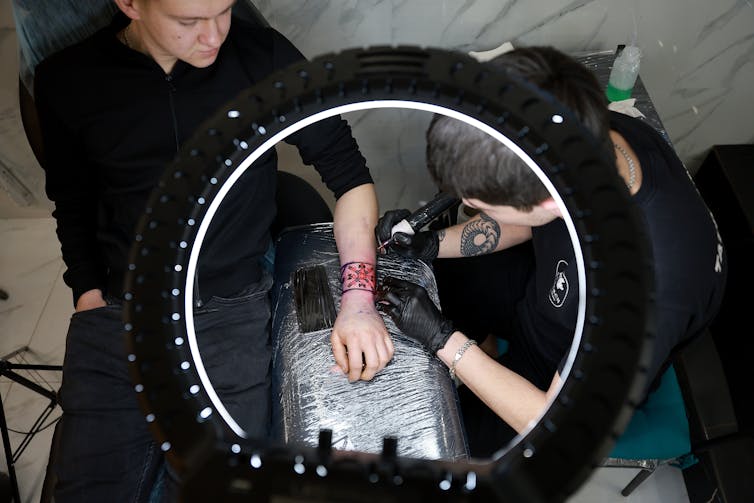
United States intelligence experts expected Russian troops to quickly overtake Kyiv shortly after Russia launched a full-fledged invasion of Ukraine on Feb. 24, 2022.
But Ukraine continues to control Kyiv and the majority of its other territory. Most Ukrainians have expressed a strong willingness to keep on fighting for their country. Ukraine has had more than 100,000 volunteers join the war since the spring of 2022 – in addition to the 1 million people drafted that year.
While Russian President Vladimir Putin has justified the war in part by saying that Ukrainians and Russians are “one people,” Ukrainians have made it pretty clear that they disagree.
As a scholar of Eastern Europe, I think that Russia’s attack on Ukraine has galvanized a sense of Ukrainian national pride and resolve, which they express by continuing to fight for their country despite massive losses – including more than 140,000 casualties – and widespread destruction.
Ukrainians fighting a common enemy
Ukrainians launched protests in 2013 that eventually helped overthrow a pro-Russian president, Viktor Yanukovych, in early 2014. Yanukovych had chosen to not sign a popular agreement that would have brought Ukraine closer to Western Europe with new trade and political deals.
Around this time, Ukraine was a divided nation. It was largely split between the pro-Russian eastern part of the country, nostalgic for the former days of the Soviet Union, and the Ukrainian-speaking, pro-European western side.
Ukrainians’ self-perception and sense of national identity began to shift after 2014, when Putin invaded two eastern regions of Ukraine with strong ties to Russia – known as the Donbas region – and annexed the Crimea, a southern peninsula of Ukraine.
Between 2014 and 2021, the number of Ukrainians who started to identify themselves as Ukrainian citizens, as opposed to residents of Eastern Europe, Europeans, or citizens of the world, grew from 51% in 2013 to 63% in 2021, according to a poll from Ukraine’s National Academy of Sciences Institute of Sociology.
Over the course of 2022, the war touched virtually all parts of the country, unifying people against a common enemy. This identity provided people with a sense of security in a world that, for them, became increasingly unstable.
In July 2022, 85% of Ukrainians identified first and foremost as citizens of Ukraine, according to the Ukrainian independent research group Kyiv International Institute of Sociology.

Despite losses, Ukrainians ready to fight
Ukrainians have sustained heavy losses in the war but have maintained the will to fight. Facing high stakes with the threat of extermination of the Ukrainian nation from the notions of the Russian government that Ukraine never had a tradition of statehood, Ukrainians have persevered in their determination to defend their homeland despite mounting casualties and unexpected calamities.
In November 2022, U.S. Joint Chiefs of Staff chairman Mike Milley estimated that around 100,000 Russian and 100,000 Ukrainian soldiers – in addition to 40,000 Ukrainian civilians – had been killed or injured in the war. More than 7.5 million people have also fled their homes in Ukraine as a result of the war.
By comparison, fighting between the Ukrainian military and Russia-backed separatists between 2014 and 2022 killed over 14,000 Ukrainians, including soldiers and civilians.
About 89% of Ukrainians said in April 2022 that they thought Russian troops were trying to commit genocide – meaning a total annihilation of a group of people – against Ukrainians, according to Rating, an independent Ukrainian sociological group.
But Ukrainians’ trauma has not stopped people from wanting to defend their country from Russia.
In November 2022, 95% of Ukrainians said that it is necessary to continue to fight against Russia, even if Russian forces continue shelling Ukrainian cities and targeting civilians, according to the 2023 Munich Annual Security Report.
Ukrainians want to reclaim their land
“Our objective is to liberate all of our territories,” Ukrainian President Volodymyr Zelenskyy said in January 2023, while appealing for more Western military support.
Ukrainians have also expressed their determination to free all Ukrainian territories from Russian occupation, returning to the 1991 country borders that Ukraine held when it declared independence from the Soviet Union. At the time, the Donbas and Crimea were part of Ukraine.
For 93% of Ukrainians, victory in the war means liberating all Ukrainian territories, including Crimea and the Donbas, from Russian control.
As of November 2022, Ukraine had regained more than half of the territory Russia claimed that year. This left Russia with control over about 17% of Ukraine, the lowest percentage since April 2022.
As Ukrainians have pushed Russia back from their territory, their fight for land appears to have reinforced their support and love for their country.
An estimated 75% of Ukrainians said in August 2022 that they feel pride for their homeland. Over the past year, Ukrainians’ pride and joy for their country have doubled, jumping from from 34% to 75%.

Ukrainians use nation branding to fight
Ukrainians’ willingness to fight Russia helped boost their country’s international reputation – and galvanize Western countries to issue condemnations and sanctions against Russia, while offering increasing military support for Ukraine.
People around the world have waved Ukraine’s blue and yellow flag during protests in support of Ukraine, or hung it outside their homes to show support for Ukraine.
Ukraine’s government has used advertising companies to help project positive images to Ukrainians and foreigners alike during the war, encouraging all people to “be brave” like Ukraine and continue the fight against Russia.
International military experts have argued that, with increasing Western military aid, Ukraine is better positioned than Russia to win the war.
Ukrainians also appear largely optimistic about the future. According to a December 2022 poll, about 75% of Ukrainians were completely confident that Ukraine would win the war against Russia.
Tatsiana Kulakevich does not work for, consult, own shares in or receive funding from any company or organization that would benefit from this article, and has disclosed no relevant affiliations beyond their academic appointment.
This article was originally published on The Conversation. Read the original article.







